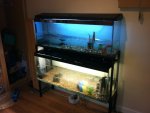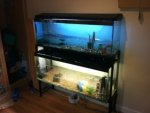pavett1990
New member
- Joined
- Dec 29, 2012
- Messages
- 71
- Reaction score
- 0
- Points
- 0
- Location
- Bridgend, S Wales
- Country
- United Kingdom
hey guys iv had a look through forum but cannot find an answer i am looking for iv had a look through a few pics in the tank photo thread to see what is on the bottom of tank but i am still not 100% sure on what to do..
when i bought my Axolotl i was given gravel, which i have removed and added coral sand which had bits of small rocks in there which i tried to seive out as much as i can but it does still contain little bits.. (only so much a lad can do with a sieve bending over a 4ft tank trying to get all the little bits out.
iv been told different things like:
- gravel is ok
- gravel is not ok
- sand is ok
- sand is not ok
- clear bottom is better.
- reflection off bottom of tank will stress them..
- filter can cause stress
i just dont know what to have as a "perfect" Axolotl set up..
im quite new to having the Axolotl and the only other pet i have in a tank is a yellow belly turtle which is in his own tank with basically garden stones.. so im not sure of the different names of sand and things.. i see in some photos there is a black sand looking substrate in one or 2 of thanks,, does anyone know what this is called?
any info would be fantastic here guys..
thanks very much
ashley
when i bought my Axolotl i was given gravel, which i have removed and added coral sand which had bits of small rocks in there which i tried to seive out as much as i can but it does still contain little bits.. (only so much a lad can do with a sieve bending over a 4ft tank trying to get all the little bits out.
iv been told different things like:
- gravel is ok
- gravel is not ok
- sand is ok
- sand is not ok
- clear bottom is better.
- reflection off bottom of tank will stress them..
- filter can cause stress
i just dont know what to have as a "perfect" Axolotl set up..
im quite new to having the Axolotl and the only other pet i have in a tank is a yellow belly turtle which is in his own tank with basically garden stones.. so im not sure of the different names of sand and things.. i see in some photos there is a black sand looking substrate in one or 2 of thanks,, does anyone know what this is called?
any info would be fantastic here guys..
thanks very much
ashley


